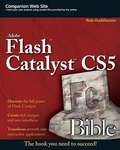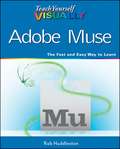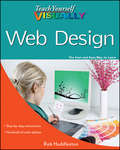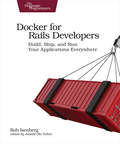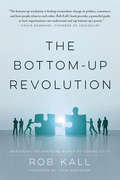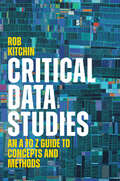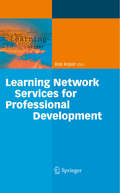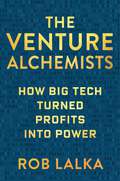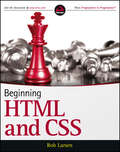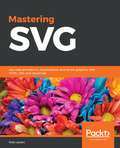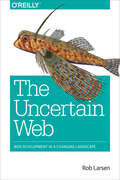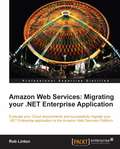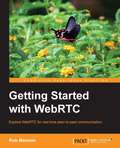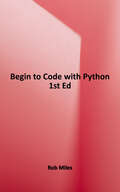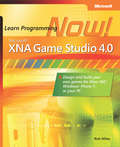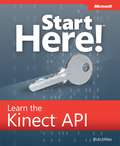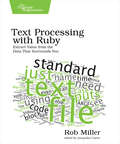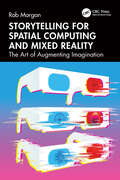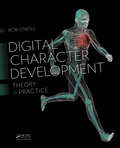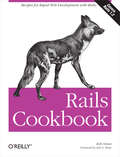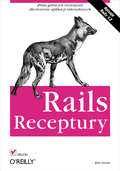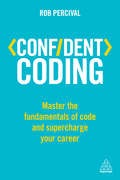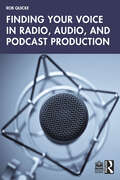- Table View
- List View
Flash Catalyst CS5 Bible
by Rob HuddlestonLearn to use the new Flash Catalyst to create rich Internet applications Adobe Flash Catalyst enables you to take designs from Photoshop and Illustrator and convert them into rich Flash-based applications-without writing or even understanding one line of code. It may sound too good to be true, but this helpful reference shows you how to leverage the Flash skills you already have in order to convert your ideas into functioning applications. You'll explore everything from the basics of the Flex framework to using Flash Builder to complete conversion of an application. Shows you how to use the eagerly anticipated Flash Catalyst to convert assets from Illustrator and Photoshop directly into Flex components without ever needing to write code Reviews the basics of the Flex framework and rich Internet applications Demonstrates how to import comps and assets into Flash Builder in order to create an application Convert your ideas from design into functioning applications-and avoid writing complex code-with this authoritative resource. Note: CD-ROM/DVD and other supplementary materials are not included as part of eBook file.
Teach Yourself VISUALLY Adobe Muse
by Rob HuddlestonA visual learner's guide to creating beautiful, functional websites without writing a line of code Adobe Muse allows graphic and visual designers to leverage the skills they already have in graphic design programs such as Adobe InDesign to create engaging, visually stunning websites without needing to write code. Veteran web designers as well as those new to website creation will learn to outline what a site needs and who it serves, as well as all about generating a look and feel, implementing the design as a working page, testing functionality, taking the site live, and keeping it going. Adobe Muse empowers graphic designers to create spectacular, functional websites without coding, and this visual guide makes it fast and easy to learn Muse Covers planning the site, designing the page layout, converting the layout to a website, adding multimedia content, and publishing a site Presented in the highly acclaimed Visual step-by-step format that breaks big topics into bite-sized modules and shows exactly what to expect at every step A companion website provides materials for experimentation to help you plan and develop your site Adobe Muse provides graphic and visual designers with the flexibility they have longed for as they design websites; this full-color book helps visual learners master Adobe Muse quickly and easily.
Teach Yourself VISUALLY Web Design
by Rob HuddlestonThe mechanics of Web design made easy for visual learnersAn effective Web site combines good graphic design principles with a functional user interface. This colorful, step-by-step guide shows visual learners how to plan, develop, and publish a site, all with easy-to-follow lessons. Each task is illustrated with screen shots accompanied by numbered steps. You'll learn all the tools and techniques for creating great-looking Web sites that users will love.Good Web design incorporates basic graphic design principles as well as the techniques required to make a site easy to navigate and user-friendlyThose who learn best when someone shows them how will quickly get up to speed with the full-color screen shots and step-by-step illustrations in this visual guideCovers planning a site, creating eye-popping content with popular Adobe tools, building in functionality with HTML and CSS, testing the site, taking it live, and keeping it up to dateCompanion Web site features code and design examples for experimentationIf you find learning easier when someone shows you how to do something, you'll quickly learn to build Web sites with Teach Yourself VISUALLY Web Design.
Docker for Rails Developers: Build, Ship, and Run Your Applications Everywhere
by Rob IsenbergDocker does for DevOps what Rails did for web development--it gives you a new set of superpowers. Gone are "works on my machine" woes and lengthy setup tasks, replaced instead by a simple, consistent, Docker-based development environment that will have your team up and running in seconds. Gain hands-on, real-world experience with a tool that's rapidly becoming fundamental to software development. Go from zero all the way to production as Docker transforms the massive leap of deploying your app in the cloud into a baby step. Docker makes life as a Ruby and Rails developer easier. It helps build, ship, and run your applications, solving major problems you face every day. It allows you to run applications at scale, adding new resources as needed. Docker provides a reliable, consistent environment that's guaranteed to work the same everywhere. Docker lets you do all things DevOps without needing a PhD in infrastructure and operations. Want to spin up a cluster to run your app? No problem. Scale it up or down at will? You bet. Start by running a Ruby script without having Ruby installed on the local machine. Then Dockerize a Rails application and run it using containers, including creating your own custom Docker images tailored for running Rails apps. Describe your app declaratively using Docker Compose, specifying the software dependencies along with everything needed to run the application. Then set up continuous integration, as well as your deployment pipeline and infrastructure. Along the way, find out the best practices for using Docker in development and production environments. This book gives you a solid foundation on using Docker and fitting it into your development workflow and deployment process. What You Need:All you need is a Windows, Mac OS X or Linux machine to do development on. This book guides you through the process of installing Docker. Some basic familiarity with Linux/Unix is recommended even if you're using a Windows machine.
The Bottom-up Revolution: Mastering the Emerging World of Connectivity
by Rob KallBarack Obama, Bernie Sanders, Hillary Clinton, George W. Bush, Sir Richard Branson, Steve Jobs, and Mark Zuckerberg have all said that that change or growth happen from the bottom up.But what does it mean and how do you do “bottom up” better and smarter? Bottom up is a way of life and a way of doing business. Bottom-Up: The Connection Revolution, picks up where Malcolm Gladwell’s Tipping Point left off. It is a how-to book for businesses, leaders, organizations, activists, and individuals, cracking wide-open humankind’s biggest trend in seven million years. By understanding the roots and implications of “bottom up” and “top down” you’ll be better able to tap the incredible power of this trend, as the billionaire founders of Google, Facebook, Craigslist and Twitter have done.
Critical Data Studies: An A to Z Guide to Concepts and Methods
by Rob KitchinCritical Data Studies has come of age as a vibrant, interdisciplinary field of study. Taking data as its primary analytical focus, the field theorises the nature of data; examines how data are produced, managed, governed and shared; investigates how they are used to make sense of the world and to perform practical action; and explores whose agenda data-driven systems serve.This book is the first comprehensive A-Z guide to the concepts and methods of Critical Data Studies, providing succinct definitions and descriptions of over 400 key terms, along with suggested further reading. The book enables readers to quickly navigate and improve their comprehension of the field, while also acting as a guide for discovering ideas and methods that will be of value in their own studies. Critical Data Studies is essential reading for students and scholars from across the sciences, social sciences and humanities, as well as those who work with data professionally who want to extend and enrich their conceptual and practical understanding of data and their use.This will be available as an Open Access book.
Learning Network Services for Professional Development
by Rob KoperA "Learning Network" is a community of people who help each other to better understand and handle certain events and concepts in work or life. As a result - and sometimes also as an aim - participating in learning networks stimulates personal development, a better understanding of concepts and events, career development, and employability. "Learning Network Services" are Web services that are designed to facilitate the creation of distributed Learning Networks and to support the participants with various functions for knowledge exchange, social interaction, assessment and competence development in an effective way. The book presents state-of-the-art insights into the field of Learning Networks and Web-based services which can facilitate all kinds of processes within these networks.
The Venture Alchemists: How Big Tech Turned Profits Into Power
by Rob LalkaWe once idolized tech entrepreneurs for creating innovations that seemed like modern miracles. Yet our faith has been shattered. We now blame them for spreading lies, breaking laws, and causing chaos. Yesterday’s Silicon Valley darlings have become today’s Big Tech villains. Which is it? Are they superheroes or scoundrels? Or is it more complicated, some blend of both?In The Venture Alchemists, Rob Lalka demystifies how tech entrepreneurs built empires that made trillions. Meta started as a cruel Halloween prank, Alphabet began as a master’s thesis that warned against corporate deception, and Palantir came from a campus controversy over hateful speech. These largely forgotten origin stories show how ordinary fears and youthful ambitions shaped their ventures—making each tech tale relatable, both wonderfully and tragically human. Readers learn about the adversities tech entrepreneurs overcame, the troubling tradeoffs they made, and the tremendous power they now wield. Using leaked documents and previously unpublished archival material, Lalka takes readers inside Big Tech’s worst exploitations and abuses, alongside many good intentions and moral compromises.But this story remains unfinished, and The Venture Alchemists ultimately offers hope from the people who, decades ago, warned about the risks of the emerging Internet. Their insights illuminate a path toward more responsible innovations, so that technologies aren’t dangerous weapons but valuable tools that ensure progress, improve society, and enhance our daily lives.
Beginning HTML and CSS
by Rob LarsenEverything you need to build websites with the newest versions of HTML and CSSIf you develop websites, you know that the goal posts keep moving, especially now that your website must work on not only traditional desktops, but also on an ever-changing range of smartphones and tablets. This step-by-step book efficiently guides you through the thicket. Teaching you the very latest best practices and techniques, this practical reference walks you through how to use HTML5 and CSS3 to develop attractive, modern websites for today's multiple devices. From handling text, forms, and video, to implementing powerful JavaScript functionality, this book covers it all.Serves as the ultimate beginners guide for anyone who wants to build websites with HTML5 and CSS3, whether as a hobbyist or aspiring professional developerCovers the basics, including the different versions of HTML and CSS and how modern websites use structure and semantics to describe their contentsExplains core processes, such as marking up text, images, lists, tables, forms, audio, and videoDelves into CSS3, teaching you how to control or change the way your pages look and offer tips on how to create attractive designsExplores the jQuery library and how to implement powerful JavaScript features, such as tabbed content, image carousels, and moreGet up to speed on HTML5, CSS3, and today's website design with this practical guide. Then, keep it on your desk as a reference!
Mastering SVG: Ace web animations, visualizations, and vector graphics with HTML, CSS, and JavaScript
by Rob LarsenTake the plunge and develop cross-browser-compatible and responsive web designs with SVGKey FeaturesMaster the art of custom animations and visualizations with SVG, CSS, and JavaScriptCombine SVG with third-party libraries and frameworks such as React, JQuery, D3, and Snap.svg for GUI-rich appsCreate an awesome user experience with high-performance graphics for your web applicationsBook DescriptionSVG is the most powerful image format in use on the web. In addition to producing resolution-independent images for today's multi-device world, SVG allows you to create animations and visualizations to add to your sites and applications. The simplicity of cross-platform markup, mixed with familiar modern web languages, such as CSS and JavaScript, creates a winning combination for designers and developers alike.In this book, you will learn how to author an SVG document using common SVG features, such as elements and attributes, and serve SVG on the web using simple configuration tips for common web servers. You will also use SVG elements and images in HTML documents.Further, you will use SVG images for a variety of common tasks, such as manipulating SVG elements, adding animations using CSS, mastering the basic JavaScript SVG (API) using Document Object Model (DOM) methods, and interfacing SVG with common libraries and frameworks, such as React, jQuery, and Angular.You will then build an understanding of the Snap.svg and SVG.js APIs, along with the basics of D3, and take a look at how to implement interesting visualizations using the library. By the end of the book, you will have mastered creating animations with SVG.What you will learnDeliver the elements that make up an SVG image Replace your old CSS sprites with SVGUnderstand animation and data visualization with SVG are explained in pure JavaScript and using common librariesUse SVG to scale images across multiple devices easily Harness the power of CSS animations and transformations to manipulate your SVG images in a replicable, remixable wayInterface SVG with common libraries and frameworks, such as jQuery, React, and AngularWho this book is forThis book is for web developers and designers looking to add animation to their projects. Some experience with HTML, CSS, and JavaScript is required.
The Uncertain Web: Web Development in a Changing Landscape
by Rob LarsenWhat’s the best way to develop for a Web gone wild? That’s easy. Simply scrap the rules you’ve relied on all these years and embrace uncertainty as a core tenet of design. In this practical book, veteran developer Rob Larsen outlines the principles out what he calls The Uncertain Web, and shows you techniques necessary to successfully make the transition.By combining web standards, progressive enhancement, an iterative approach to design and development, and a desire to question the status quo, your team can create sites and applications that will perform well in a wide range of present and future devices. This guide points the way.Topics include:Navigating thousands of browser/device/OS combinationsFocusing on optimal, not absolute solutionsFeature detection, Modernizr, and polyfillsRWD, mobile first, and progressive enhancementUIs that work with multiple user input modesImage optimization, SVG, and server-side optionsThe horribly complex world of web videoThe Web we want to see in the future
Amazon Web Services: Migrating your .NET Enterprise Application
by Rob LintonThis practical, step-by-step guide follows the process of moving a sample Enterprise .NET application to the Amazon Cloud.Companies that have designed, developed, and hosted applications based on the Microsoft .NET technology stack should not miss out on this book. If you are looking to expand into using the vast array of services available on the Amazon Cloud but are unsure how to proceed, then this will help to get you on your way.Administrators or developers managing such applications should have basic experience of the platform and the web servers that thay are intending to move to Amazon. No knowledge of AWS is required.
Getting Started with WebRTC
by Rob MansonThe book will follow a step-by-step tutorial approach to construct an application that allows video conferencing and calls between two browsers and a system for sharing files among a group.This book is ideal for developers new to the WebRTC standards who are interested in adding sensor-driven, real-time, peer-to-peer communication to their web applications. You will only need basic experience with HTML and JavaScript.
The Very Best of Fesshole: Britain confesses anonymously
by Rob Manuel'Puerile, reprehensible and very, very funny' Adam Kay'I love Fesshole. Every single one is a masterclass in storytelling' Jay Rayner'Hilarious! The only guide any alien would need to find out what humans are really like' David Schneider'The wild, the wonderful, the frankly unbelievable and the downright disgusting. Under the anonymity of the internet people confess their most embarrassing secrets and it might not be good for their souls, but it's great for the readers!' Richard K Herring It's confession time, folks! Things have been building up inside of you for too long. Secrets you thought you'd never share with another soul are bubbling to the surface begging for release.And where better to let it all out (/laugh at someone else's misfortune) than on the internet.Fesshole is a Twitter account (@fesshole) which allows people to anonymously confess their innermost thoughts, deepest, darkest secrets, and their most outrageously funny faux pas - but will the online world absolve you of your sins?This book contains the greatest confessions to date, and a whole heap of new ones.After all, if you can't confide in strangers on the internet, who can you tell?
The Very Best of Fesshole: The New Fesstament
by Rob Manuel'A ridiculously reliable source of joy, shock and horror' - James O'Brien 'I sometimes read one of those fesses and wonder if I submitted it myself the night before, after a few beers' - James May The anonymous voices of the internet are back, ready to spill their deepest, darkest secrets and side-splitting faux pas.In this eagerly anticipated second coming, Rob Manuel has once again compiled the most jaw-dropping, knee-slapping, and cringe-inducing confessions out there.Prepare to immerse yourself in the seedy underbelly of human nature, where no secret is too taboo, no embarrassment is left unexplored, and laughter knows no bounds. Once again, the online world becomes an unexpected arena of collective catharsis, and this riotous read is an addictive deep dive into our shared guilt.This must have book contains favourite viral confessions, and a whole heap of new ones. After all, if you can't confide in strangers on the internet, who can you tell?
Begin to Code with Python
by Rob MilesStart writing software that solves real problems, even if you have absolutely no programming experience! This friendly, easy, full-color book puts you in total control of your own learning, empowering you to build unique and useful programs. Microsoft has completely reinvented the beginning programmer’s tutorial, reflecting deep research into how today’s beginners learn, and why other books fall short. Begin to Code with Python is packed with innovations, from its “Snaps” prebuilt operations to its “Make Something Happen” projects. Whether you’re a total beginner or you’ve tried before, this guide will put the power, excitement, and fun of programming where it belongs: in your hands! <p><p>Easy, friendly, and you’re in control! Learn how to... <p>•Get, install, and use powerful free tools to create modern Python programs <p>•Learn key concepts from 170 sample programs, and use them to jumpstart your own <p>•Discover exactly what happens when a program runs <p>•Approach program development with a professional perspective <p>•Learn the core elements of the Python language <p>•Build more complex software with classes, methods, and objects <p>•Organize programs so they’re easy to build and improve <p>•Capture and respond to user input <p>•Store and manipulate many types of real-world data <p>•Define custom data types to solve specific problems <p>•Create interactive games that are fun to play <p>•Build modern web and cloud-based applications <p>•Use pre-built libraries to quickly create powerful software <p><p>About This Book <p>•For absolute beginners who’ve never written a line of code <p>•For anyone who’s been frustrated with other beginning programming books or courses <p>•For people who’ve started out with other languages and now want to learn Python <p>•Works with Windows PC, Apple Mac, Linux PC, or Raspberry Pi <p>•Includes mapping of MTA exam objectives that are covered in this book, as well as an appendix with further explanation of some of the topics on the exam
Microsoft® XNA® Game Studio 4.0: Learn Programming Now!
by Rob MilesNow you can build your own games for your Xbox 360®, Windows® Phone 7, or Windows-based PC--as you learn the underlying concepts for computer programming. Use this hands-on guide to dive straight into your first project--adding new tools and tricks to your arsenal as you go. No experience required! Learn XNA and C# fundamentals--and increase the challenge with each chapter Write code to create and control game behavior Build your game's display--from graphics and text to lighting and 3-D effects Capture and cue sounds Process input from keyboards and gamepads Create features for one or multiple players Tweak existing games--and invent totally new ones
Start Here!™ Learn the Kinect™ API
by Rob MilesReady to learn Kinect programming? Start Here!TM Learn the fundamentals of programming with the KinectTM API--and begin building apps that use motion tracking, voice recognition, and more. If you have experience programming with C#--simply start here! This book introduces must-know concepts and techniques through easy-to-follow explanations, examples, and exercises. Here's where you start learning Kinect Build an application to display Kinect video on your PC Have Kinect take photographs when it detects movement Draw on a computer screen by moving your finger in the air Track your body gestures and use them to control a program Make a program that understands your speech and talks back to you Play a part in your own augmented reality game Create an "air piano" using Kinect with a MIDI device
Text Processing with Ruby: Extract Value from the Data That Surrounds You
by Rob MillerText is everywhere. Web pages, databases, the contents of files--for almost any programming task you perform, you need to process text. Cut even the most complex text-based tasks down to size and learn how to master regular expressions, scrape information from Web pages, develop reusable utilities to process text in pipelines, and more.Most information in the world is in text format, and programmers often find themselves needing to make sense of the data hiding within. It might be to convert it from one format to another, or to find out information about the text as a whole, or to extract information fromit. But how do you do this efficiently, avoiding labor-intensive, manual work?Text Processing with Ruby takes a practical approach. You'll learn how to get text into your Ruby programs from the file system and from user input. You'll process delimited files such as CSVs, and write utilities that interact with other programs in text-processing pipelines. Decipher character encoding mysteries, and avoid the pain of jumbled characters and malformed output.You'll learn to use regular expressions to match, extract, and replace patterns in text. You'll write a parser and learn how to process Web pages to pull out information from even the messiest of HTML.Before long you'll be able to tackle even the most enormous and entangled text with ease, scything through gigabytes of data and effortlessly extracting the bits that matter.What You Need:This book requires a passing familiarity with the Ruby programming language, and assumes that you already have Ruby installed on your computer.
Storytelling for Spatial Computing and Mixed Reality: The Art of Augmenting Imagination
by Rob MorganThis is a clear, accessible manual of storytelling techniques and learning activities for spatial computing, augmented reality and mixed reality. It covers the key skills that the next generation of digital storytellers will need, providing readers with practical tools for creating digital stories and adventures out in the real world.Drawing on more than a decade of experience, veteran immersive storyteller Rob Morgan provides strategies and techniques for augmenting players and places with digital narrative. Readers will try out key ideas through a range of practical exercises, building up their own portfolio of augmented/spatial narrative projects.Storytelling for Spatial Computing and Mixed Reality provides insight on everything from narrative pacing to conditional and emergent storytelling for augmented/spatial technology. Each chapter addresses key questions about the affordances - and ethics - of augmenting players' realities, helping students and practitioners explore this new storytelling frontier.This book will be invaluable to students of game design, experience design and interactive narrative. It provides theories, best practices and case studies also relevant to creative professionals in games, XR, immersive theatre, theme parks and brand experience.
Digital Character Development: Theory and Practice, Second Edition
by Rob O'NeillEvery animated film and video game production spends a large percentage of its resources and time on advancing the quality of the digital characters inhabiting the world being created. This book presents the theory and practice behind the creation of digital characters for film and games using software-agnostic descriptions that apply to any animation application. It provides insight from a real production environment and the requirements that such an environment imposes. With rich illustrations and visual code examples throughout, this book provides a comprehensive roadmap to character development for both professionals and students.
Rails Cookbook: Recipes for Rapid Web Development with Ruby
by Rob OrsiniRails Cookbook is packed with the solutions you need to be a proficient developer with Rails, the leading framework for building the new generation of Web 2.0 applications. Recipes range from the basics, like installing Rails and setting up your development environment, to the latest techniques, such as developing RESTful web services.With applications that are code light, feature-full and built to scale quickly, Rails has revolutionized web development. The Rails Cookbook addresses scores of real-world challenges; each one includes a tested solution, plus a discussion of how and why it works, so that you can adapt the techniques to similar situations. Topics include:Modeling data with the ActiveRecord librarySetting up views with ActionView and RHTML templatesBuilding your application's logic into ActionControllerTesting and debugging your Rails applicationBuilding responsive web applications using JavaScript and AjaxEnsuring that your application is security and performs wellDeploying your application with Mongrel and ApacheUsing Capistrano to automate deploymentUsing the many Rails pluginsWorking with graphicsWhether you're new to Rails or an experienced developer, you'll discover ways to test, debug and secure your applications, incorporate Ajax, use caching to improve performance, and put your application into production. Want to get ahead of the Web 2.0 curve? This valuable cookbook will save you hundreds of hours when developing applications with Rails.
Rails. Receptury
by Rob OrsiniZbiór gotowych rozwišza? dla twórców aplikacji internetowych Instalacja i uruchomienie ?rodowiska Rails Przetwarzanie grafiki Korzystanie z technologii AJAX Dynamiczny rozwój sieci sprawia, ?e tradycyjne programy sš stopniowo wypierane przez aplikacje sieciowe dost?pne z poziomu przeglšdarki internetowej -- wygodne, niezale?ne od systemu operacyjnego i ?atwe w aktualizowaniu. Nadal jednak kluczowe znaczenie ma szybko?? ich przygotowywania i modyfikowania. Dzi?ki zbiorom bibliotek zwanym "frameworks" proces tworzenia takich produktów znacznie si? skróci? -- umo?liwia to programistom skoncentrowanie si? na faktycznej funkcjonalno?ci tworzonego narz?dzia, poniewa? biblioteki te przejmujš wiele typowych i wspólnych dla wszystkich aplikacji zada?. W?ród dost?pnych w sieci narz?dzi tego typu coraz wi?kszš popularno?? zyskuje Ruby on Rails, powoli stajšcy si? "ikonš" nurtu Web 2.0. Tworzone za jego pomocš systemy sš zwarte i ?atwe do skalowania, a ich kod ?ród?owy jest przejrzysty i czytelny. "Rails. Receptury" to zestaw porad i rozwišza? problemów, przed którymi stajš programi?ci stosujšcy ten zbiór bibliotek w swojej pracy. Omówione tu zagadnienia przydadzš si? zarówno poczštkujšcym, jak i do?wiadczonym twórcom aplikacji sieciowych. Przeczytasz tu o instalowaniu, konfigurowaniu i uruchamianiu ?rodowiska Rails, po?šczeniach z bazami danych za pomocš ActiveRecord, generowaniu kodu HTML, zabezpieczaniu programów i tworzeniu kontrolerów odpowiadajšcych za funkcjonalno?? systemu. Dowiesz si?, jak wdra?a? aplikacje Rails i korzysta? w nich z mo?liwo?ci oferowanych przez mechanizmy AJAX. Instalacja i uruchomienie ?rodowiska Komunikacja z bazami danych Wy?wietlanie danych w przeglšdarce Wykorzystywanie szablonów RHTML Generowanie kodu XML i RSS Przetwarzanie danych z formularzy Personalizacja narz?dzi Korzystanie z JavaScript i AJAX Zabezpieczanie aplikacji Rails Optymalizacja aplikacji Wdra?anie i utrzymywanie systemów na serwerach Przetwarzanie obrazów Skorzystaj ze sprawdzonych receptur i do?šcz do twórców Web 2.0!
Confident Coding: Master the Fundamentals of Code and Supercharge Your Career
by Rob PercivalIf you want to master the fundamentals of coding and kick start your career, Confident Coding is the book for you. Everyone has a digital life, but too few truly understand how the software that dominates the world actually works. Coding is one of the most in demand skills on the job market and grasping the basics can advance your creative potential and make you stand out from the crowd. Rob Percival gives you a step-by-step learning guide to HTML, CSS, JavaScript, Python, building iPhone apps, building Android apps and debugging. On reading this book and honing your skills through practice, you will be able to code in each of these languages, build your own website, build your own app and have the confidence to supercharge your employability. Confident Coding provides you with the roadmap you need to enhance your professional life through coding, with insightful and inspirational guidance, including real life success stories, on how to use your new skills. The ability to code can give your CV the edge on the competition, give you greater autonomy and improve your work performance. If you are a self-employed entrepreneur, being able to create your own website or app can grant you valuable freedom and revolutionize your business. If you are an aspiring developer, this book will give you the building blocks to embark on this career path.
Finding Your Voice in Radio, Audio, and Podcast Production
by Rob QuickeThis book provides a unique identity-centered approach to radio, audio, and podcast production which encourages readers to build their confidence and create audio content that matters to them. Written for those just starting out in audio production and focusing on the process of their self-development, readers will learn how to use sound to express themselves in a variety of ways and to create powerful stories in the process – all with the tools already available to them. At the centre of this approach is the author’s R.E.A.L. method, referring to the creation of audio that is relatable, engaging, authentic, and liberating. Students will learn to apply this concept to each step of the production process, from planning and writing through to interviewing, broadcasting, and responding to feedback. By the end of this book readers will have developed a working knowledge of podcast, audio, and radio production alongside their own means of self-expression. Supported by exercises and interviews with audio practitioners throughout, Finding Your Voice in Radio, Audio, and Podcast Production is a key resource for anyone approaching radio, audio, or podcasting for the first time. A supporting companion website with Instructor and Student Resources is available at www.robquicke.com.
